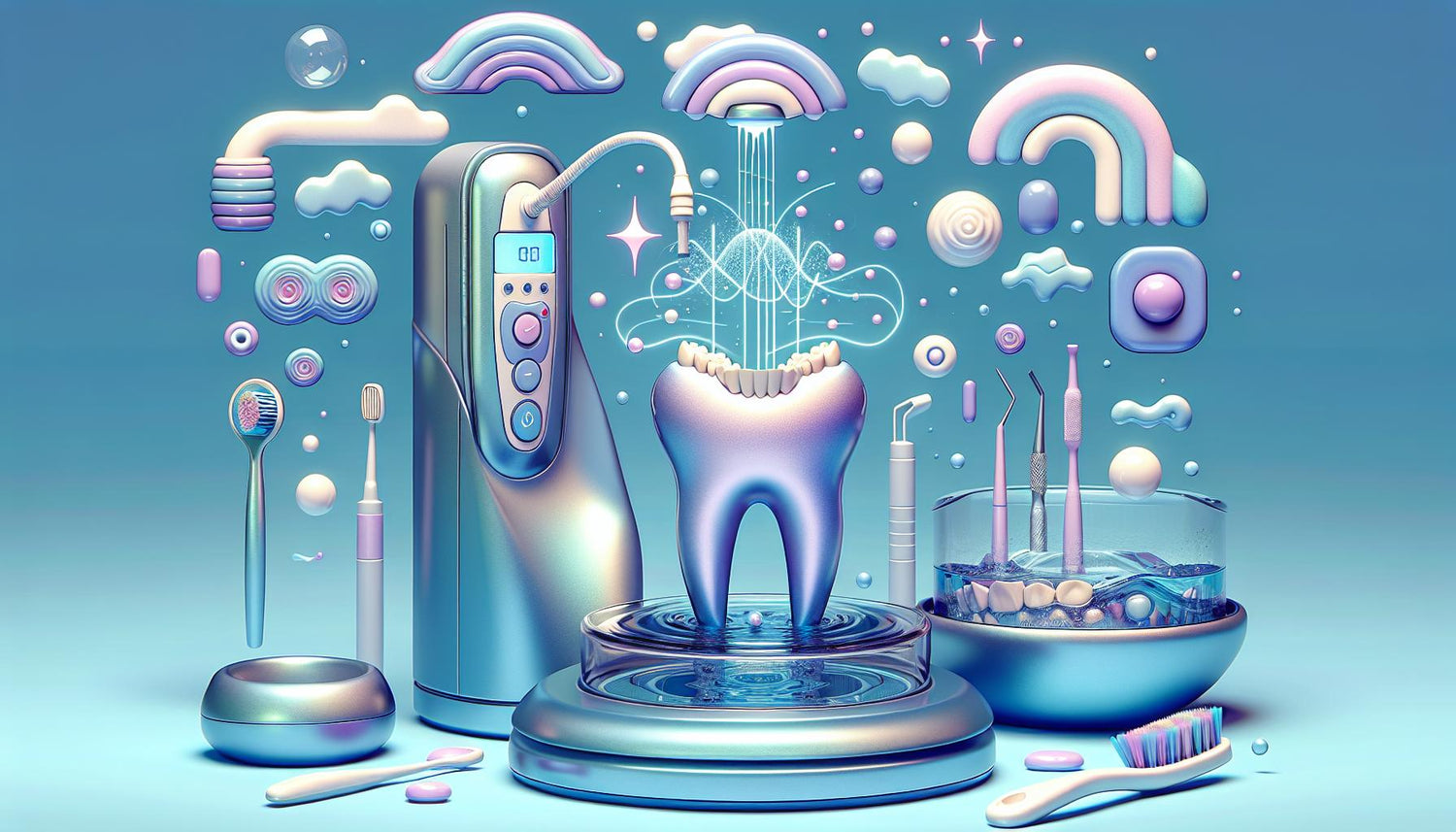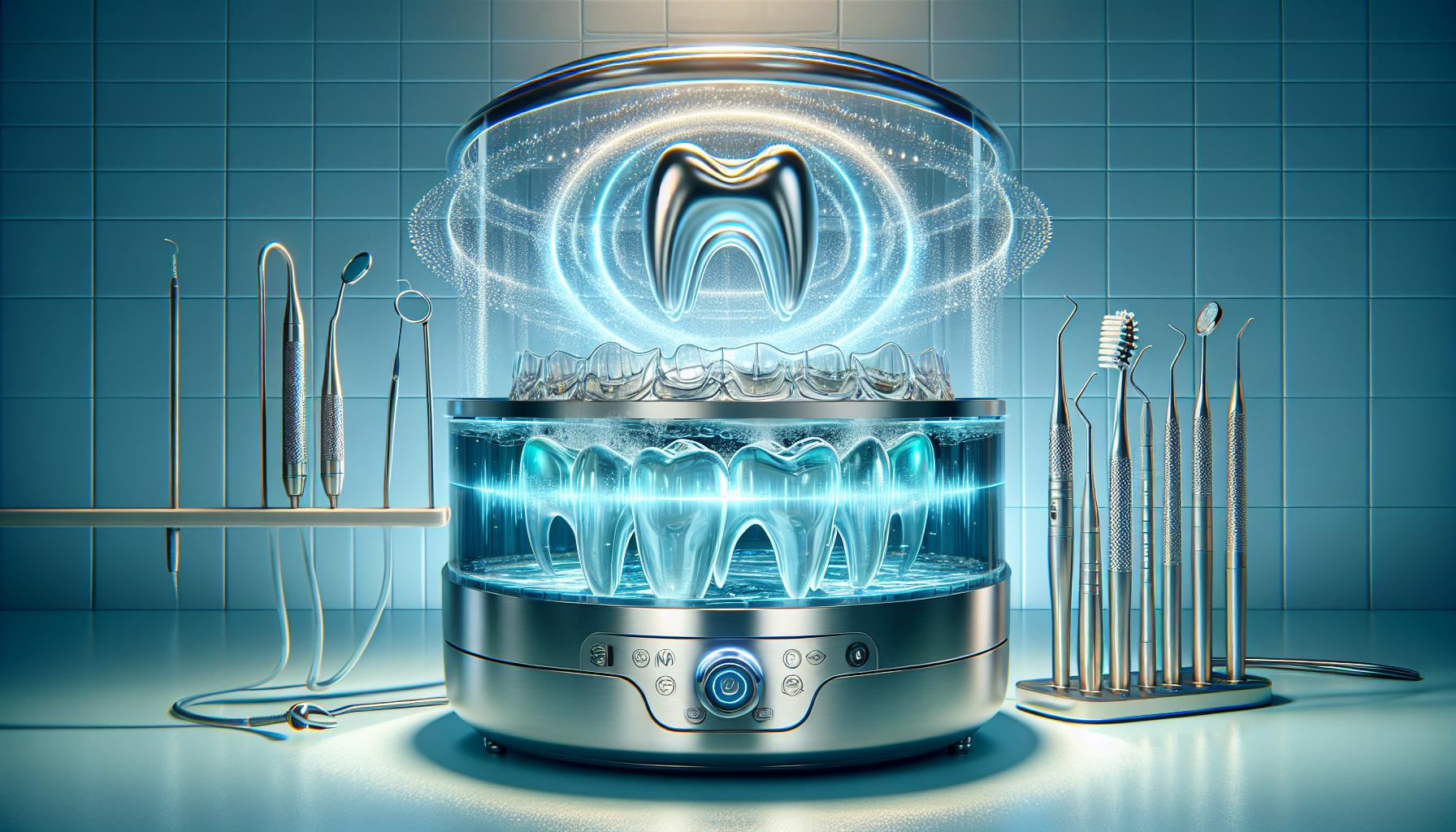Maintaining oral hygiene is crucial for your overall health, especially if you wear dentures or retainers. In recent years, ultrasonic cleaning technology has transformed the way many approach dental appliance maintenance. This article explores the efficiency and convenience of ultrasonic cleaners compared to conventional brushing and soaking methods. We’ll delve into how the best retainer cleaner machine options—such as the ultrasonic retainer cleaner and ultrasonic invisalign cleaner—work, and why cleaning dentures with an ultrasonic cleaner could be the smarter choice for your dental health routine.
Table of Contents
- Introduction
- Traditional Denture Cleaning Methods
- Understanding Ultrasonic Cleaning Technology
- Comparing Efficiency and Convenience
- Key Features of the Best Retainer Cleaner Machines
- Considerations When Choosing an Ultrasonic Cleaner
- Practical Tips for Effective Denture and Retainer Cleaning
- Conclusion
Introduction
When it comes to oral hygiene, especially for those using dental appliances such as dentures, retainers, or Invisalign, choosing the right cleaning method is essential. Traditional methods like manual brushing and soaking have been widely used for decades, but recent advancements have introduced ultrasonic technology that is quickly gaining acceptance. Devices like the ultrasonic retainer cleaner and retainer cleaner machine offer a promising alternative that requires less effort while promising superior cleaning results.
In this article, we compare the traditional denture cleaning techniques with modern ultrasonic cleaning methods. If you’re considering upgrading your cleaning routine, read on to see why options like the best ultrasonic retainer cleaner and the best retainer cleaner machine might be the future of denture maintenance.
Traditional Denture Cleaning Methods
For many years, the most common ways to keep dental appliances clean have been manual brushing and soaking. Let’s review these methods in detail.
Manual Brushing
Manual brushing involves using a soft toothbrush along with specialized cleaning solutions to scrub the surface of your denture or retainer. This method:
- Relies on user technique: The thoroughness of cleaning largely depends on how well you brush every nook and cranny.
- Requires regular attention: You must remove debris and plaque buildup by dedicating time to each cleaning session.
- Poses risks of wear: Over time, vigorous scrubbing can cause tiny abrasions or scratches on the appliance’s surface if the brush is too abrasive.
Soaking Solutions
Another common technique involves soaking dentures or retainers in a solution of cleaning agents:
- Passive cleaning process: Soaking allows the cleaning solution to break down residues and bacteria.
- Supplementary method: Often, soaking is combined with manual brushing to enhance overall cleanliness.
- Solution-related issues: Some solutions may cause discoloration or even wear out delicate materials if used too frequently.
While these traditional methods have served well in the past, they demand significant manual effort and may not provide the most thorough cleaning, especially in hard-to-reach areas.
Understanding Ultrasonic Cleaning Technology
Ultrasonic cleaning represents a leap forward in the realm of dental appliance hygiene. Utilizing advanced technology, these devices have become increasingly popular for their precision and ease of use.
How Ultrasonic Cleaners Work
Ultrasonic cleaners operate using high-frequency sound waves that travel through a cleaning fluid. These waves generate microscopic bubbles in a process called cavitation. When these bubbles collapse, they create tiny jets of energy that dislodge dirt, plaque, and bacteria from the surface of your dental appliance. This process is:
- Non-abrasive: No physically aggressive scrubbing is necessary, which helps preserve the integrity of the appliance.
- Highly effective: The ultrasonic retainer cleaner can reach crevices and areas that are difficult to clean manually.
- Automated: Once set up, the device cleans with minimal supervision, ensuring consistency in cleaning every time.
Advantages of Ultrasonic Dental Appliances Cleaners
- Superior Cleaning Accuracy: Whether you use an ultra sonic cleaner for retainer or cleaning dentures with an ultrasonic cleaner, the technology ensures a thorough cleaning that targets microscopic residues.
- Gentle on Appliances: The non-abrasive method protects retainers, dentures, and Invisalign aligners from the wear and tear associated with manual cleaning.
- Increased Convenience: No need for intensive manual effort; simply place your dental appliance into the retainer cleaner machine, and let the device do the work.
- Time-Saving: Many users find that ultrasonic cleaning methods save precious time, allowing them to focus on other aspects of their daily routine.
Comparing Efficiency and Convenience
Cleaning Power and Precision
Ultrasonic cleaners, such as the best ultrasonic retainer cleaner, excel at eliminating bacteria and debris from surfaces that traditional methods might miss. The cavitation process makes it possible to clean intricate details of your denture or retainer without needing to manually scrub every tight corner. This means:
- Deeper Clean: The tiny bubbles reach and lift away residues far better than a toothbrush or soaking solution alone.
- Enhanced Hygiene: Removing biofilm and bacteria efficiently reduces the risk of infections and ensures that your dental appliance remains in top condition.
Ease of Use and Maintenance
Using an ultrasonic cleaning machine is remarkably straightforward:
- User-Friendly Interface: Most retainer cleaner machines are designed with simplicity in mind, often featuring pre-set cycles and easy-to-read controls.
- Minimal Manual Labor: Unlike brushing, you merely place your retainer or dentures into the machine, add a cleaning solution (if necessary), and press start. The process is largely automated.
- Consistent Results: Every cleaning cycle is uniform, reducing the variability that comes with manual cleaning efforts.
Time Efficiency
Time is one of the most significant advantages of ultrasonic dental cleaners:
- Quick Operating Cycles: Many ultrasonic invisalign cleaner models offer cleaning cycles that last only a few minutes, making it easy to integrate the process into your busy schedule.
- Reduced Preparation Time: There’s no need for lengthy brushing sessions or complicated setup with soak solutions.
- Reliable Daily Use: For individuals with demanding lifestyles, the minimal effort and quick turnaround time make ultrasonic cleaning an attractive, modern solution.
Key Features of the Best Retainer Cleaner Machines
Choosing the right ultrasonic cleaning device can seem daunting given the variety available. Below, we break down the most important features that distinguish the best retainer cleaner machine in the market today.
Ultrasonic Retainer Cleaner
- Compact Design: Ideal for personal use at home, these cleaners are designed to fit easily on a countertop.
- Precision Cleaning: Tailored ultrasonic frequencies target the unique surfaces of retainers, ensuring comprehensive cleaning without damage.
- Ease of Programming: With pre-set cycles, users can automatically initiate cleaning, making it foolproof even for those with minimal technical know-how.
Ultra Sonic Cleaner for Retainer
- Multi-Appliance Use: Many machines can also accommodate Invisalign or dentures, providing a versatile solution for dental appliance care.
- High-Frequency Operation: The optimal frequency range ensures all contaminants are effectively dislodged.
- Safety Features: Built-in timers and auto shut-off prevent overexposure, protecting your appliances from potential damage.
Ultrasonic Invisalign Cleaner
- Specialized Cleaning Programs: These devices are programmed to remove plaque without affecting the transparency or integrity of the aligners.
- Excellent for Daily Use: Regular, gentle cleaning prevents buildup without the need for tedious manual methods.
- Versatility: Besides Invisalign, many of these machines double up as effective cleaning solutions for dentures and retainers.
Considerations When Choosing an Ultrasonic Cleaner
Investing in an ultrasonic cleaning device means evaluating several aspects to ensure that the model you choose meets your specific needs.
User-Friendliness
- Simplicity: The best ultrasonic retainer cleaner doesn’t require a steep learning curve. Look for intuitive designs that help you start the cleaning cycle with minimal instructions.
- Automation: Automated cycles mean you can set it and forget it, making regular cleaning hassle-free.
Portability and Design
- Compact Size: A more portable design makes it easier for users who travel or have limited counter space.
- Ergonomic Build: Devices should be built with materials that are both durable and aesthetically pleasing, seamlessly fitting into your bathroom decor.
Cost-effectiveness
- Long-term Value: While ultrasonic cleaners can be more expensive upfront compared to manual cleaning supplies, the durability and effectiveness of the best retainer cleaner machine offer great long-term savings.
- Maintenance Costs: Consider models that require minimal maintenance and have readily available replacement parts or accessories.
Practical Tips for Effective Denture and Retainer Cleaning
- Regular Cleaning Routine: Incorporate ultrasonic cleaning into your daily or weekly routine to prevent buildup and maintain good oral hygiene. Even if you sometimes use manual brushing, combining methods can ensure a higher level of cleanliness.
- Use Recommended Cleaning Solutions: Follow the manufacturer’s guidelines for the cleaning solution compatible with your device. This ensures optimal cavitation and overall effectiveness.
- Consistent Maintenance: Ensure your ultrasonic cleaning device remains in good working order by regularly checking for signs of wear or residue buildup inside the machine.
- Follow Timers and Cycles: Trust the built-in timers on your retainer cleaner machine. The controlled cycles prevent over-cleaning or damage to your dental appliance.
- Store Your Dental Appliances Safely: After cleaning, dry your dentures or retainers properly before storing them in a clean, dry container. This practice avoids any recontamination and prolongs the lifespan of your appliances.
- Integrate Multiple Techniques: While ultrasonic cleaning is highly efficient, you may find that combining it with occasional manual brushing and soaking (using appropriate cleaning agents) yields the best overall results.
Conclusion
As dental care standards evolve, so does the approach to maintaining the cleanliness of dental appliances. Ultrasonic cleaning technology offers a powerful, efficient, and convenient alternative to traditional methods like manual brushing and soaking. Devices such as the ultrasonic retainer cleaner, ultra sonic cleaner for retainer, and ultrasonic invisalign cleaner demonstrate that the best retainer cleaner machine options are not only effective at removing stubborn residues and bacteria but are also designed with the modern user’s convenience in mind.
For those looking to upgrade their dental hygiene routine, cleaning dentures with an ultrasonic cleaner is a forward-thinking approach that minimizes manual labor and maximizes cleanliness. While traditional cleaning methods have their place in everyday maintenance, the precision, speed, and ease of ultrasonic cleaners are hard to ignore.
When choosing an ultrasonic cleaning device, consider factors like user-friendliness, design, and cost-effectiveness to select a model that aligns best with your needs. By investing in advanced technology, you’re not only ensuring the longevity of your dental appliances but also taking a significant step toward enhanced oral health.
In summary, whether you are looking for a dedicated ultrasonic retainer cleaner or a versatile machine that can serve as the best retainer cleaner machine for multiple types of dental appliances, modern ultrasonic technology provides undeniable advantages over traditional cleaning methods. Embrace the convenience and efficiency of these advanced systems to ensure your smile stays healthy and vibrant for years to come.
By integrating advanced ultrasonic cleaning methods into your routine, you can enjoy a cleaner, safer, and more effective way to care for your dentures, retainers, and Invisalign aligners. The benefits of reduced manual effort, more thorough cleaning, and time savings make it a clear winner over traditional methods. Make the switch today and experience the future of dental appliance care with an ultrasonic cleaning solution that fits your lifestyle.


